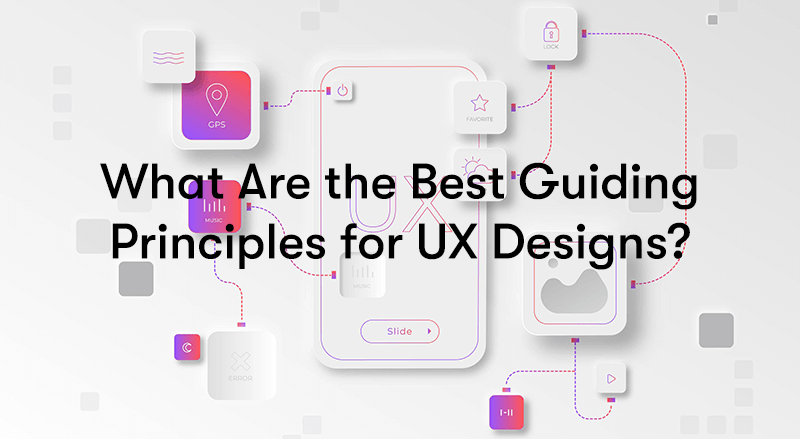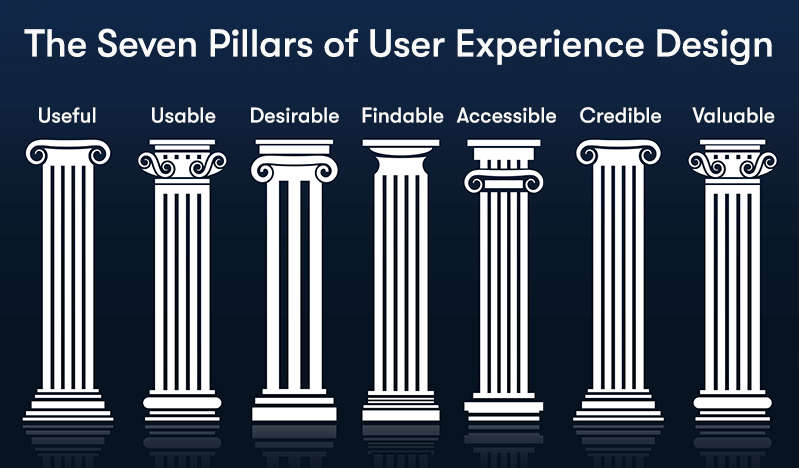UX Best Practices and Principles
User Experience (UX) design is the difference between a frustrating encounter and a delightful interaction with a product or service. UX best practices and principles are the compass for designers, ensuring that every aspect of the user's experience is finely tuned. From user-centricity and accessibility to clarity, consistency, and ethical considerations, these principles shape designs that are functional and enjoyable.
Join us in exploring the crucial elements that define exceptional UX, as we delve into the strategies and insights underpinning user satisfaction and success.
What is UX?
UX stands for User Experience, and it refers to a person's overall experience when interacting with a product, system, or service. UX design is a multidisciplinary field that focuses on creating products and experiences that are user-centric, easy to use, and enjoyable.
UX design is not limited to websites or apps; it applies to a wide range of products and services, including physical products and digital interfaces. Good UX design can lead to higher user satisfaction, increased user loyalty, and better business outcomes.
What Are the Best Practices for UX Designers?

UX designers follow best practices to create effective and user-centred designs. Here are some key best practices for UX designers:
User-Centred Design
Always prioritise the needs, goals, and preferences of the users. Understand your target audience through research and tailor your design to meet their requirements.
Research
Conduct thorough user research to gain insights into user behaviours, pain points, and motivations. Use methods like surveys, interviews, usability testing, and analytics to inform your design decisions.
Usability
Focus on creating designs that are easy to use. Ensure that users can accomplish their tasks efficiently and intuitively. Usability testing can help identify and address usability issues.
Information Architecture
Organise content and information logically. Create clear and intuitive navigation structures, menus, and hierarchies to help users find what they need easily.
Prototyping
Build prototypes or wireframes to visualise and test your design concepts. Prototyping helps you identify problems and iterate on your design before development begins.
Consistency
Maintain consistency in design elements such as layout, colour schemes, typography, and interaction patterns across the product. Consistency contributes to a cohesive and user-friendly experience.
Accessibility
Ensure your designs are accessible to all users, including those with disabilities. Follow accessibility guidelines and consider factors like keyboard navigation, screen reader compatibility, and image text alternatives.
Mobile Optimisation
Design for mobile devices and responsive web design. Mobile optimisation is crucial as a growing number of users access digital products on smartphones and tablets.
Performance
Pay attention to the performance of your designs. Slow-loading pages or laggy interactions can frustrate users. Optimise assets and code for speed.
Feedback and Iteration
Gather feedback from users and stakeholders throughout the design process and be willing to iterate and make improvements based on this feedback.
Collaboration
Collaborate effectively with cross-functional teams, including developers, product managers, and marketers. Good communication is essential for aligning goals and ensuring a consistent user experience.
User Testing
Conduct usability testing with real users to identify issues and validate design decisions. Regular user testing helps uncover usability problems that may not be apparent during the design phase.
A/B Testing
Implement A/B testing to compare design variations and determine which performs better regarding user engagement, conversion rates, or other key metrics.
User Feedback Channels
Provide channels for users to provide feedback, such as contact forms, feedback buttons, or surveys. Act on user feedback to improve the product continuously.
Stay Informed
Keep up-to-date with the latest design trends, tools, and technologies. The field of UX design is constantly evolving, so ongoing learning is essential.
Ethical Considerations
Be aware of the ethical implications of your design choices. Avoid dark patterns or practices that could deceive or harm users.
Documentation
Document your design decisions, guidelines, and patterns to ensure consistency and make it easier for team members to follow best practices.
Remember that UX design is an iterative process, and continuous improvement is key. By following these best practices and remaining focused on the user, UX designers can create products and experiences that are both functional and enjoyable for their target audience.
What Are the Best Guiding Principles for UX Designs?

Guiding principles in UX design help designers make informed decisions and ensure that their work aligns with the needs and expectations of users. Here are some of the best guiding principles for UX design:
User-Centred Design
The primary principle of UX design is to prioritise the needs and goals of users. Always design with the user in mind, aiming to create an intuitive, efficient, and enjoyable product for them.
Clarity
Keep your designs simple and clear. Avoid unnecessary complexity and distractions. Users should be able to understand the interface and how to use it without confusion.
Consistency
Throughout the product, maintain consistency in design elements, such as colours, typography, and navigation. Consistency helps users build mental models and reduces cognitive load.
Accessibility
Design for inclusivity. Ensure your product is accessible to people with disabilities by following accessibility guidelines and standards, such as WCAG (Web Content Accessibility Guidelines).
Efficiency
Prioritise efficiency in user interactions. Users should be able to accomplish their tasks quickly and with minimal effort. Streamline workflows and reduce friction in the user journey.
Feedback
Provide clear and timely feedback to users. Let them know when an action has been successfully completed or if there's an error. Feedback enhances the user's sense of control and understanding.
Learnability
Design interfaces that are easy to learn, even for new users. Use familiar design patterns and provide onboarding or guidance when necessary.
Flexibility
Recognise that users have different needs and preferences. Allow for customisation and personalisation where appropriate, enabling users to tailor the experience to their liking.
Hierarchy and Information Architecture
Organise content and features logically. Use clear hierarchies and effective information architecture to help users find what they're looking for.
Prioritisation
Prioritise features and content based on user needs and business goals. Not all features are equally important; focus on what matters most to your users.
Emotion and Delight
Strive to create a positive emotional experience. Aesthetically pleasing design, delightful interactions, and unexpected moments of joy can leave a lasting impression on users.
Testing and Iteration
Continuously test your designs with real users and iterate based on their feedback. Usability testing and user feedback are invaluable for making improvements.
Sustainability
Consider the environmental impact of your design choices, such as the energy consumption of digital products and the materials used in physical products.
Long-Term Thinking
Design with long-term sustainability in mind, aiming for a product that can adapt and evolve to meet changing user needs and technological advancements.
These guiding principles are a foundation for UX designers to create products and experiences that prioritise user satisfaction, usability, and ethical considerations. Adhering to these principles can lead to more successful and user-friendly designs.
What Are the Seven Pillars of User Experience Design?

The Seven Pillars of User Experience Design is a concept that provides a framework for understanding and assessing different aspects of the user experience. The seven pillars are:
1. Useful
2. Usable
3. Desirable
4. Findable
5. Accessible
6. Credible
7. Valuable
Ensuring that each pillar is effectively designed can lead to a more comprehensive and successful user experience. It's worth noting that while these areas can be considered separately for analytical purposes, they are deeply interconnected in practice. Here are the seven pillars in more detail:
Useful
The design must serve a purpose and fulfil user needs. It should provide value and help users achieve their goals or solve their problems. A useful design addresses real user needs and adds meaning to their interactions.
Usable
Usability is a core pillar. A design must be easy to use and navigate. Users should be able to interact with the product or interface without confusion or frustration. A usable design ensures efficiency and effectiveness in task completion.
Desirable
A desirable design goes beyond functionality and usability to create an emotional connection with users. It should be aesthetically pleasing and evoke positive emotions. Aesthetic design choices can enhance the overall user experience and develop a sense of delight.
Findable
Information and elements within the design should be easy to find. Users should be able to locate what they're looking for easily. Effective navigation, clear labelling, and logical organisation contribute to findability.
Accessible
Accessibility is crucial to ensure that the design is usable by people with disabilities. This pillar emphasises making the design inclusive and accommodating for users with various abilities and needs. Following accessibility guidelines is essential.
Credible
A credible design establishes trust and reliability. Users should feel confident that the information provided is accurate, and the product or service is trustworthy. Transparency, authenticity, and clear communication contribute to credibility.
Valuable
The design should deliver value to both users and the business. It should align with user goals while also meeting the objectives of the organisation. A valuable design can lead to user satisfaction and business success.
These seven pillars collectively help designers evaluate and create user-centred experiences. By addressing these aspects, UX designers can develop products, websites, and interfaces that function well and resonate with users, leading to positive user experiences and long-term user engagement.
The Golden Rule of UX Design

The golden rule of UX design is "Design for others as you would have them design for you." In essence, the Golden Rule of UX Design encourages designers to put themselves in the users' shoes and design with their needs and preferences in mind. By following this principle, UX designers can create more user-centred and satisfying experiences, leading to higher user satisfaction and loyalty.
Where Can You Learn More About UX Design?
Our BCS Foundation Certificate In User Experience training course is perfect for anyone who wants to increase their knowledge of User Experience. The BCS User Experience course will teach you the UX methodology, best practices, techniques, and a strategy for creating a successful user experience. The course will cover the following topics:
- Guiding Principles
- User Research
- Illustrating The Context Of Use
- Measuring Usability
- Information Architecture
- Interaction Design
- Visual Design
- User Interface Prototyping
- Usability Evaluation
Click the button below to find out more.

Final Notes On UX Best Practices
In the realm of UX design, adhering to best practices is paramount for crafting exceptional user experiences. The foundation lies in user-centricity, where understanding user needs, embracing clarity and simplicity, and ensuring accessibility are fundamental principles. Consistency, flexibility, and ethical considerations bolster the framework, while effective collaboration with cross-functional teams and continuous testing and iteration drive refinement.
As we conclude, let the golden rule of UX design, "Design for others as you would have them design for you," be our final statement.



